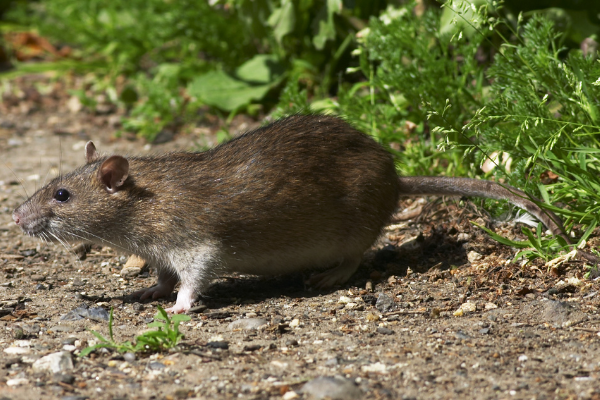
The brown rat (Rattus norvegicus), also known as the common rat, street rat, sewer rat, wharf rat, Hanover rat, Norway rat, Norwegian rat and Parisian rat, is a widespread species of common rat. One of the largest muroids, it is a brown or grey rodent with a head and body length of up to 28 cm (11 in) long, and a tail slightly shorter than that. It weighs between 140 and 500 g (5 and 17 3⁄4 oz). Thought to have originated in northern China, this rodent has now spread to all continents except Antarctica, and is the dominant rat in Europe and much of North America. With rare exceptions, the brown rat lives wherever humans live, particularly in urban areas.
Selective breeding of the brown rat has produced the fancy rat (rats kept as pets), as well as the laboratory rat (rats used as model organisms in biological research). Both fancy rats and laboratory rats are of the domesticated subspecies Rattus norvegicus domestica.
Description
The fur is usually brown or dark grey, while the underparts are lighter grey or brown. The brown rat is a rather large murid and can weigh twice as much as a black rat (Rattus rattus) and many times more than a house mouse (Mus musculus). The head and body length ranges from 15 to 28 cm (6 to 11 in) while the tail ranges in length from 10.5 to 24 cm (4 1⁄4 to 9 1⁄2 in), therefore being shorter than the head and body. Adult weight ranges from 140 to 500 g (5 to 17 3⁄4 oz).
Exceptionally large individuals can reportedly reach 900 to 1,000 g (31 1⁄2 to 35 1⁄2 oz) but are not expected outside of domestic specimens. Stories of rats attaining sizes as big as cats are exaggerations, or misidentifications of larger rodents, such as the coypu and muskrat. In fact, it is common for breeding wild brown rats to weigh (sometimes considerably) less than 300 g (10 1⁄2 oz).
Brown rats have acute hearing, are sensitive to ultrasound, and possess a very highly developed olfactory sense. Their average heart rate is 300 to 400 beats per minute, with a respiratory rate of around 100 per minute. The vision of a pigmented rat is poor, around 20/600, while a non-pigmented (albino) with no melanin in its eyes has both around 20/1200 vision and a terrible scattering of light within its vision. Brown rats are dichromates which perceive colors rather like a human with red-green colorblindness, and their color saturation may be quite faint. Their blue perception, however, also has UV receptors, allowing them to see ultraviolet lights that some species cannot.
Biology and behavior
The brown rat is nocturnal and is a good swimmer, both on the surface and underwater, and has been observed climbing slim round metal poles several feet in order to reach garden bird feeders. Brown rats dig well, and often excavate extensive burrow systems. A 2007 study found brown rats to possess metacognition, a mental ability previously only found in humans and some primates, but further analysis suggested they may have been following simple operant conditioning principles.
Communication
Brown rats are capable of producing ultrasonic vocalizations. As pups, young rats use different types of ultrasonic cries to elicit and direct maternal search behavior, as well as to regulate their mother’s movements in the nest. Although pups will produce ultrasounds around any other rats at 7 days old, by 14 days old they significantly reduce ultrasound production around male rats as a defensive response. Adult rats will emit ultrasonic vocalizations in response to predators or perceived danger;[ the frequency and duration of such cries depends on the sex and reproductive status of the rat. The female rat will also emit ultrasonic vocalizations during mating.
Chirping
Rats may also emit short, high frequency, ultrasonic, socially induced vocalization during rough and tumble play, before receiving morphine, or mating, and when tickled. The vocalization, described as a distinct “chirping”, has been likened to laughter, and is interpreted as an expectation of something rewarding. Like most rat vocalizations, the chirping is too high in pitch for humans to hear without special equipment. Bat detectors are often used by pet owners for this purpose.
In research studies, the chirping is associated with positive emotional feelings, and social bonding occurs with the tickler, resulting in the rats becoming conditioned to seek the tickling. However, as the rats age, the tendency to chirp appears to decline.
Audible communication
Brown rats also produce communicative noises capable of being heard by humans. The most commonly heard in domestic rats is bruxing, or teeth-grinding, which is most usually triggered by happiness, but can also be ‘self-comforting’ in stressful situations, such as a visit to the vet. The noise is best described as either a quick clicking or ‘burring’ sound, varying from animal to animal. Vigorous bruxing can be accompanied by boggling, where the eyes of the rat rapidly bulge and retract due to movement of the lower jaw muscles behind the eye socket.
In addition, they commonly squeak along a range of tones from high, abrupt pain squeaks to soft, persistent ‘singing’ sounds during confrontations.
Diet
The brown rat is a true omnivore and will consume almost anything, but cereals form a substantial part of its diet. Martin Schein, founder of the Animal Behavior Society in 1964, studied the diet of brown rats and came to the conclusion that the most-liked foods of brown rats include scrambled eggs, macaroni and cheese, raw carrots, and cooked corn kernels. According to Schein, the least-liked foods were raw beets, peaches, and raw celery.
Foraging behavior is often population-specific, and varies by environment and food source. Brown rats living near a hatchery in West Virginia catch fingerling fish. Some colonies along the banks of the Po River in Italy will dive for mollusks, a practice demonstrating social learning among members of this species. Rats on the island of Norderoog in the North Sea stalk and kill sparrows and ducks.
Reproduction and life cycle
The brown rat can breed throughout the year if conditions are suitable, with a female producing up to five litters a year. The gestation period is only 21 days, and litters can number up to 14, although seven is common. They reach sexual maturity in about five weeks. Under ideal conditions (for the rat), this means that the population of females could increase by a factor of three and a half (half a litter of 7) in 8 weeks (5 weeks for sexual maturity and 3 weeks of gestation), corresponding to a population growing by a factor of 10 in just 15 weeks. As a result, the population can grow from 2 to 15,000 in a year. The maximum life span is three years, although most barely manage one. A yearly mortality rate of 95% is estimated, with predators and interspecies conflict as major causes.
When lactating, female rats display a 24-hour rhythm of maternal behavior, and will usually spend more time attending to smaller litters than large ones.
Brown rats live in large, hierarchical groups, either in burrows or subsurface places, such as sewers and cellars. When food is in short supply, the rats lower in social order are the first to die. If a large fraction of a rat population is exterminated, the remaining rats will increase their reproductive rate, and quickly restore the old population level.
Females are capable of becoming pregnant immediately after giving birth, and can nurse one litter while pregnant with another. Females are able to produce and raise two healthy litters of normal size and weight without significantly changing their own food intake. However, when food is restricted, females can extend pregnancy by over two weeks, and give birth to litters of normal number and weight.
Source: Wikipedia





